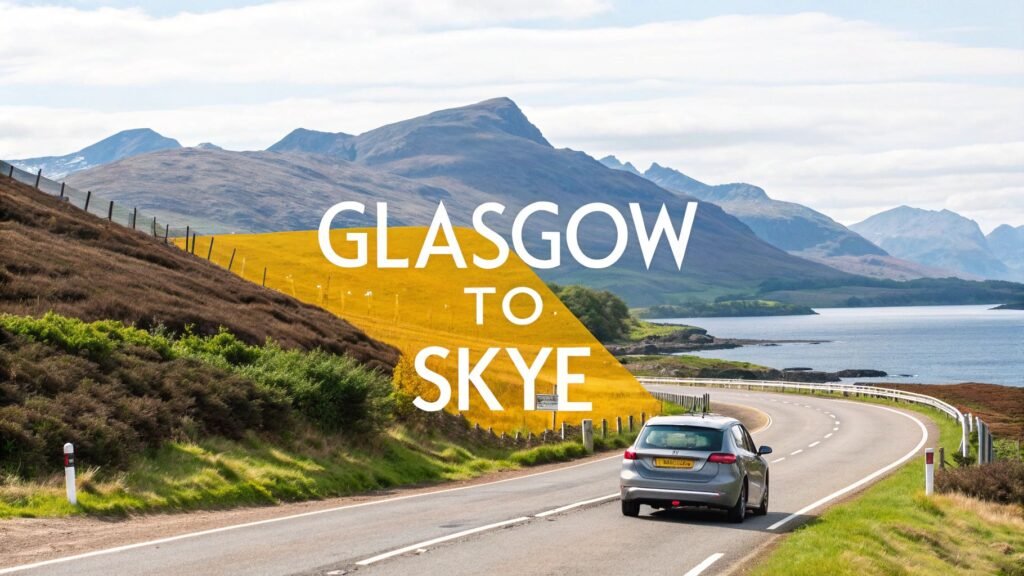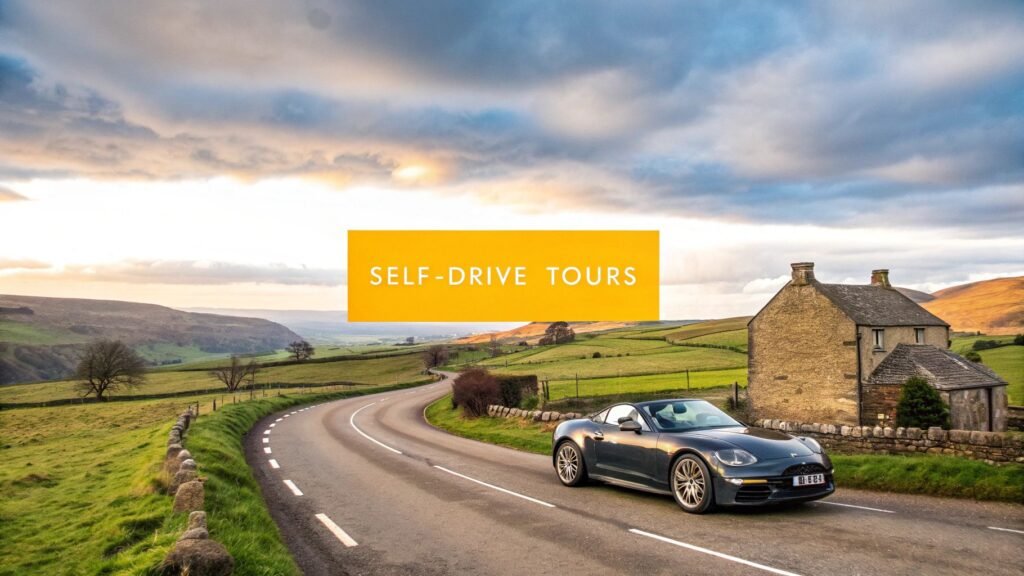The drive from Glasgow to the Isle of Skye is one of those iconic Scottish road trips for a reason. Spanning roughly 200-250 miles, it’s a journey that could technically be done in 5-6 hours. But honestly, that would be a massive missed opportunity. The real magic isn’t in reaching Skye, but in everything you discover along the way.
Your Epic Glasgow to Isle of Skye Drive
A road trip from Glasgow to the Isle of Skye is more than just getting from point A to B; it’s a genuine adventure through the heart of the Scottish Highlands. Think of this guide as your blueprint for that journey, skipping the fluff and focusing on the practical details that make a trip unforgettable. Before you even turn the key, a few key decisions will set the tone for your entire experience.
The biggest choice right off the bat? Your route. You’ll need to decide between the classic A82, which carves through the dramatic, jaw-dropping valley of Glencoe, or the A9, a scenic alternative that skirts the vast wilderness of the Cairngorms National Park. Each one offers a completely different taste of Scotland, and your choice will shape everything that follows.
Choosing Your Travel Style
First things first, how do you want to experience the Highlands? While this guide is all about the freedom of the open road, it’s good to know your options. Public transport is definitely doable. Citylink runs three direct buses a day from Glasgow right to the Isle of Skye, which is a solid choice if you’d rather not drive.
Another classic option is the train-and-ferry combo. You can ride the famous West Highland Line from Glasgow to Mallaig—a stunning journey in its own right—and then hop on the ferry to Armadale on Skye.
But for true flexibility, nothing beats having your own set of wheels. A self-drive tour means you call the shots. You can linger at that perfect viewpoint, pull over for an impromptu photo of a shaggy Highland coo, or explore that tiny single-track road that looks too tempting to ignore.
The real joy of a self-drive trip is the freedom to be spontaneous. You’re not tied to a rigid schedule. If a castle captures your imagination or you stumble upon a perfect pub for lunch, you can change your plans on a whim. That’s where the best memories are made.
Glasgow to Skye Route Options at a Glance
To help you decide which path to take, here’s a quick breakdown of the two main driving routes. Each has its own distinct personality and set of can’t-miss sights.
| Feature | Route 1 (Via A82 & Glencoe) | Route 2 (Via A9 & Cairngorms) |
|---|---|---|
| Driving Time | Approx. 5-6 hours (without stops) | Approx. 5.5-6.5 hours (without stops) |
| Scenery | Dramatic, moody, classic Highlands. Lochs and towering mountains. | Sweeping, wild, and vast. Mountains, forests, and moorlands. |
| Main Vibe | Iconic, historic, and often busier. This is the classic route. | Quieter, more about nature and open spaces. |
| Key Attractions | Loch Lomond, Glencoe, Fort William, Eilean Donan Castle | Stirling, The Cairngorms, Dalwhinnie Distillery, Aviemore |
| Best For | First-timers wanting the quintessential Highland experience. | Repeat visitors or those seeking a less-traveled, nature-focused drive. |
Ultimately, there’s no wrong answer here. It just comes down to whether you’re craving the dramatic, historic grandeur of Glencoe or the wild, open expanse of the Cairngorms.
Planning Your Itinerary
With your route in mind, the next step is to think about the bigger picture of your trip.
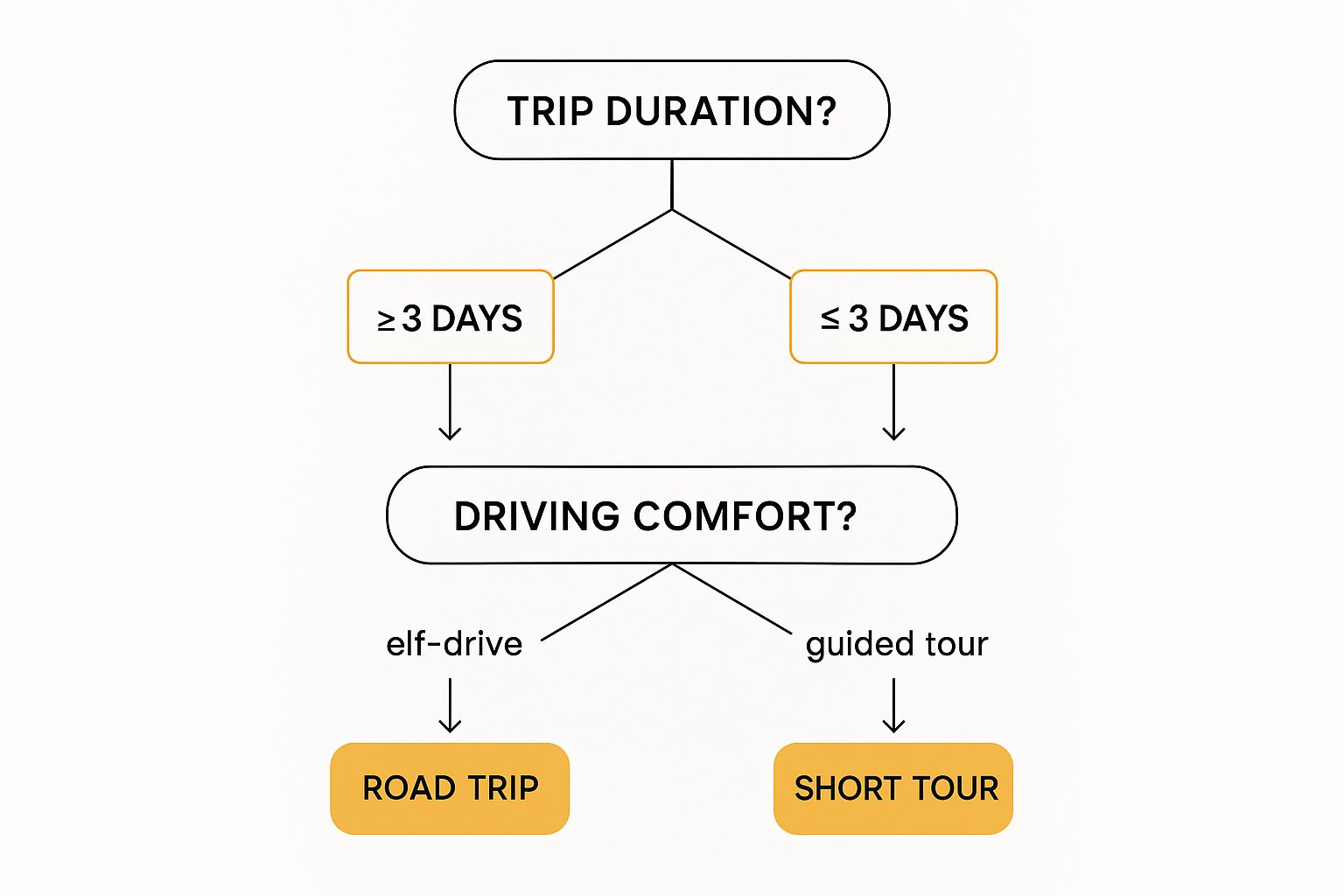
As the infographic shows, the time you have available and your comfort with driving are the two biggest factors that will shape your perfect Scottish adventure.
Here’s a simple way to frame your decision:
- Time: Got three days or less? You’ll need a direct, focused itinerary. Trying to cram too much in will just leave you feeling rushed.
- Freedom: If you value independence and want to set your own pace, exploring some Scotland self-drive tours can give you great ideas and a solid framework to build on.
- Comfort: Prefer to sit back, relax, and let an expert handle the driving and logistics? A guided tour is an excellent, stress-free option.
Think of this as the foundation for your trip. With these initial decisions made, you’re ready to start piecing together an unforgettable drive through Scotland’s most spectacular landscapes.
The Classic Drive Through Glencoe and Loch Lomond
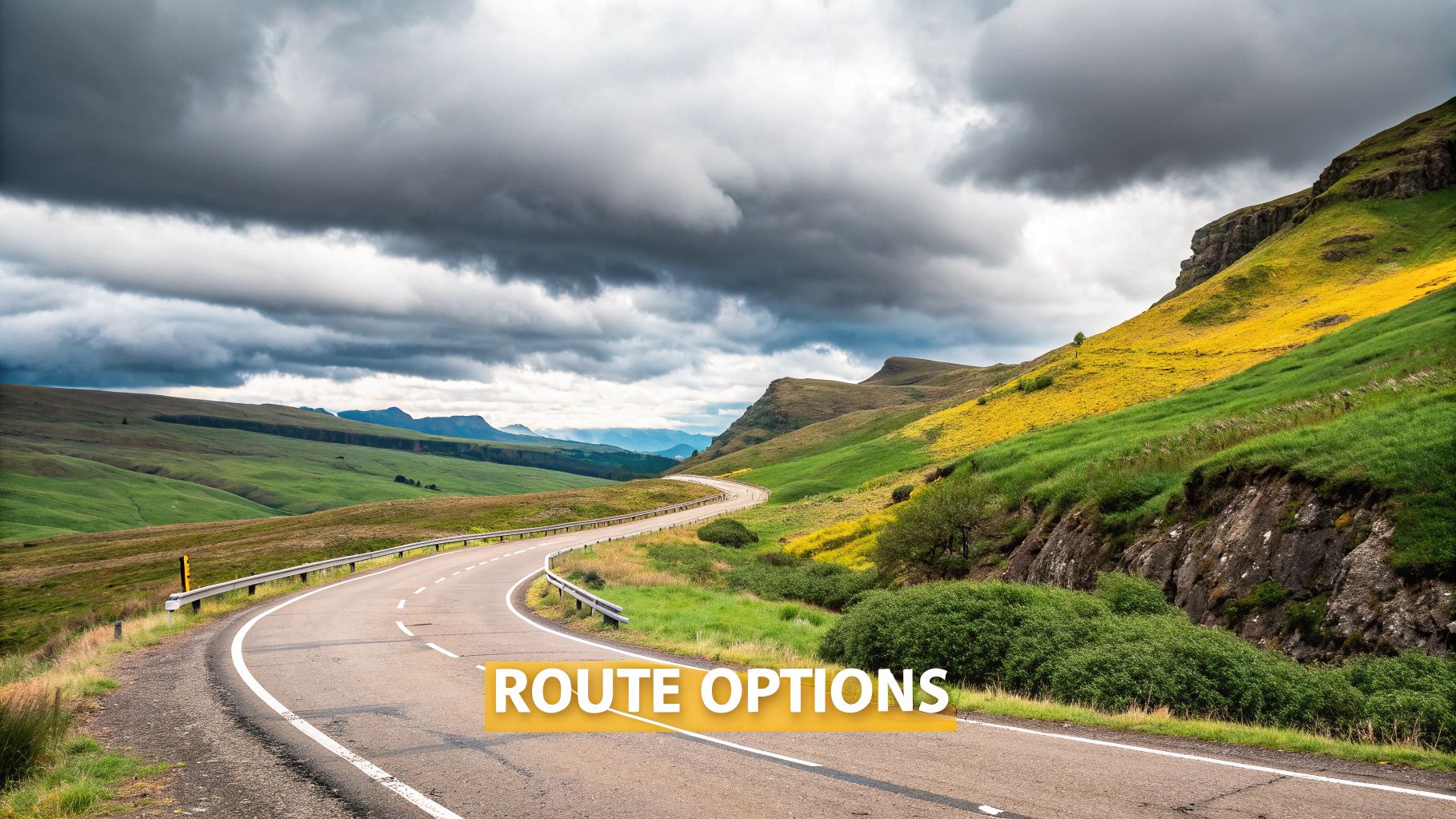
This is it—the legendary part of the Glasgow to Isle of Skye drive. You’ve seen the A82 route in countless photos and films, but trust me, seeing it through your own windscreen is something else entirely. This leg of the journey takes you from the edge of Glasgow all the way to Fort William, right through the heart of Scotland’s most iconic landscapes.
As you leave Glasgow behind, the city quickly gives way to the stunning Loch Lomond & The Trossachs National Park. The road soon starts tracing the western shore of Loch Lomond, the largest body of freshwater in Great Britain. Driving here feels like you’re getting tantalising glimpses of the loch between ancient oak woodlands.
Navigating Loch Lomond
Be prepared for the road along the loch—it can get narrow and winding in spots, so there’s no need to rush. You’ll see plenty of lay-bys for photo ops, but they fill up fast. My advice? Skip the first few packed spots and keep an eye out for the smaller, unmarked pull-offs a bit further north for a more peaceful stop.
A personal favourite of mine is the lay-by just after the village of Tarbet. It gives you this incredible, sweeping view back down the loch, usually with fewer people around. It’s the perfect place to stretch your legs and really grasp the sheer scale of it all before you press on.
Once you’re past the loch, the whole feel of the drive changes. The trees begin to thin, the hills swell into mountains, and the road cuts across the vast, beautifully empty expanse of Rannoch Moor. This desolate, boggy plateau is the perfect dramatic overture for what’s coming next.
Entering the Valley of Glencoe
And then, you arrive. There’s no mistaking the entrance to Glencoe. The road dips, and suddenly you are surrounded by steep, colossal mountains. This isn’t just a scenic drive; it’s a powerful journey through a valley steeped in bloody history—most famously the 1692 massacre of the MacDonald clan—and jaw-dropping geological grandeur.
Of course, the most famous viewpoint is for the Three Sisters, a trio of striking, near-vertical ridges. There’s a large, well-signed car park here that is absolutely worth the stop.
Pro Tip: For a perspective most tourists miss, drive just a little way past the main car park. The next, smaller lay-by on your left offers a less crowded and, in my opinion, more raw and intimate angle of the valley floor sweeping up towards the peaks.
Glencoe is so much more than a drive-through valley. To really get a feel for the place, consider a few quick stops:
- Glencoe Visitor Centre: It’s a modern, well-run centre where you can get the backstory on the area’s geology, wildlife, and history. It’s also a great spot for a coffee break with clean toilets.
- Short Walks: You don’t need to be a seasoned hiker to get out of the car. Several short, marked trails start from the car parks, letting you immerse yourself in the landscape with just a 15-20 minute walk.
- Look for Waterfalls: If there’s been even a little rain, you’ll see waterfalls cascading down the mountainsides. The Meeting of Three Waters is a beautiful and very accessible cascade right beside the road.
Approaching Fort William
As you finally exit the glen, the landscape opens up again, with the imposing figure of Ben Nevis, the UK’s highest peak, dominating the horizon. You’re now on the home stretch to Fort William, the largest town in the Highlands and the main hub for outdoor adventurers.
The A82 runs right through the middle of Fort William, so it can get pretty busy, especially in summer. If you’re stopping for lunch, I’d suggest avoiding the main high street cafes that are often full of tour bus groups. Instead, duck down a side street or head to nearby Corpach for some fantastic pub grub with views of the Caledonian Canal.
This stretch of road is the very essence of the classic Highland experience. By taking your time and seeking out those quieter moments, you’ll transform a simple drive into the first unforgettable chapter of your Scottish road trip.
Essential Stops Between Glasgow and the Skye Bridge
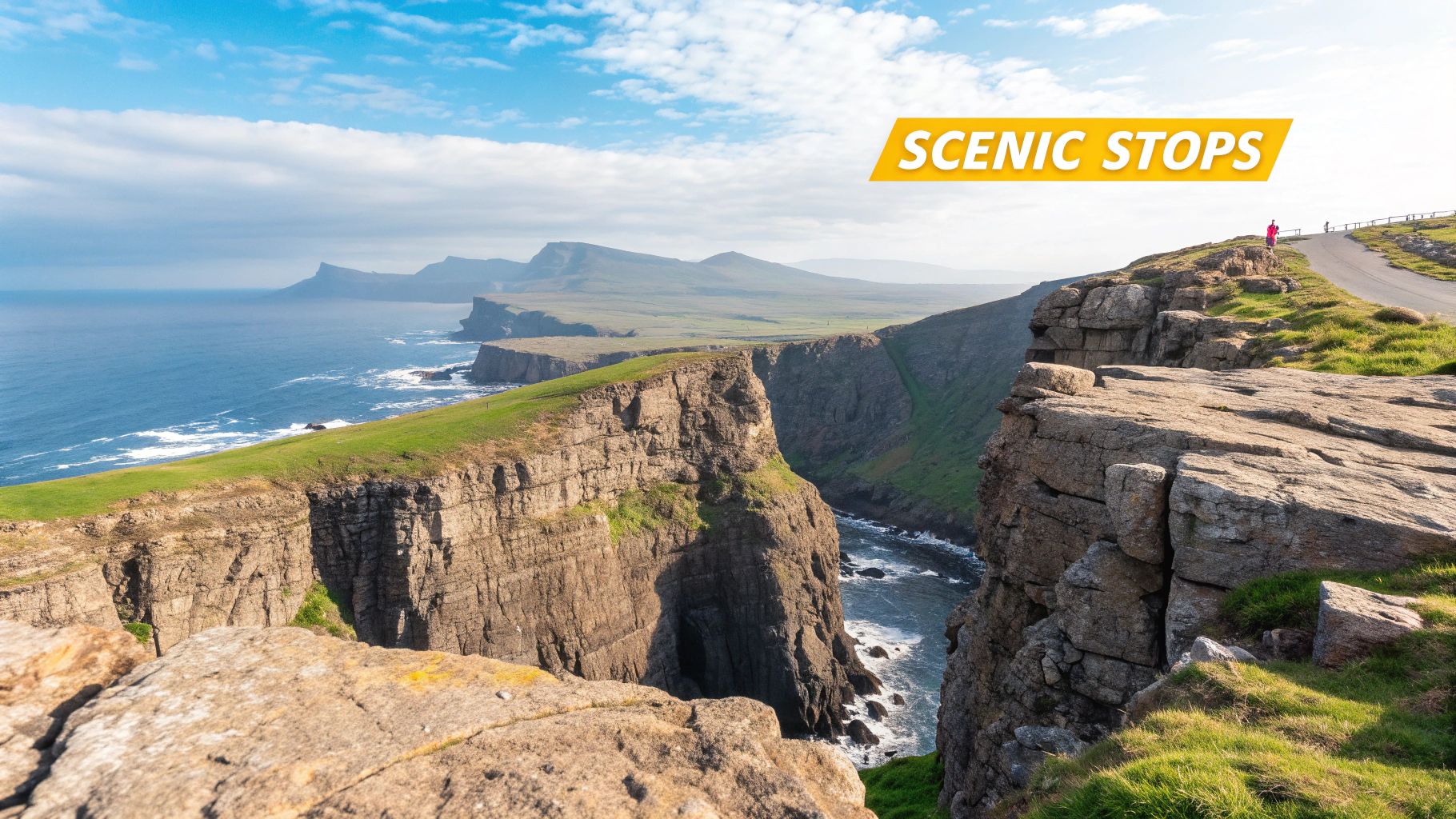
Let’s be clear: the drive from Glasgow to the Isle of Skye isn’t just about getting there. It is a huge part of the adventure itself. The real magic happens when you get out of the car. While the epic views through Glencoe are non-negotiable, it’s the smaller, more intentional stops that truly define your journey through the Highlands.
This is your chance to pepper the itinerary with local flavour and landscapes that you just can’t appreciate from behind the wheel. We’ll focus on a few key spots that give you the best bang for your buck, time-wise, along with some hard-won advice for sidestepping the crowds.
The Charm of Luss on Loch Lomond
Just under an hour out of Glasgow, before the scenery gets truly rugged, you’ll find the village of Luss. It’s your first essential pit stop. Nestled on Loch Lomond’s western bank, its impossibly quaint stone cottages and flower-filled gardens feel like they’ve been pulled from a storybook. Yes, it’s popular, but it’s popular for a reason and absolutely worth a quick visit.
A word of warning: parking can be a real headache in high season. The main car park fills up fast, so try to roll in early—before 10 AM is a good rule of thumb—if you don’t want a long trek into the village. A short stroll down to the pier is all you need for gorgeous views across the loch and a perfect excuse to stretch your legs before the main drive.
The Adventure Hub of Fort William
Pushing north, you’ll hit Fort William, the unofficial capital of the Outdoor Highlands. Sitting right under the watchful eye of Ben Nevis, it’s a bustling town and a natural midway point for lunch or stocking up on supplies. My advice? Don’t just pass through on the main road.
For a great meal that’s a bit removed from the tourist crush, check out the pubs and cafes in the nearby village of Corpach. You’ll find honest Scottish food and often get incredible views of the Caledonian Canal locks with Ben Nevis looming in the background.
Realistically, you only need about 60-90 minutes in Fort William itself unless you’re planning a bigger activity. Use it as a strategic stop to refuel both your car and yourselves before heading into the wilder, more remote sections of the drive.
The Unmissable Eilean Donan Castle
As you inch closer to the Skye Bridge, the landscape delivers one of Scotland’s most iconic sights: Eilean Donan Castle. It’s perched dramatically on a tiny island where three great sea lochs converge, and it looks exactly like every postcard you’ve ever seen. You have to stop. It’s basically a rule.
This is one of the most photographed spots in the entire country, so managing your visit is everything. Here are a few tips from experience:
- Timing is Everything: To dodge the tour bus swarm, aim to be there right when it opens (10 AM) or in the last hour before it closes. It makes a world of difference.
- Beyond the Bridge: The classic photo is from the car park, but don’t stop there. Walk around the shoreline a bit. You’ll find unique angles that don’t include a dozen other tourists in your shot.
- Hidden Costs: You need a ticket to actually walk across the bridge and go inside the castle. If you’re tight on time or money, the views from the visitor centre area are just as magnificent and completely free.
Visiting Eilean Donan feels like a rite of passage on the road to Skye. It’s the grand finale before you cross onto the island. While these are just a few handpicked highlights, the entire region is packed with incredible sights. For more ideas, exploring a comprehensive guide to touring Scotland can help you unearth even more gems. After all, the best journey is the one you make your own, one amazing stop at a time.
Crossing to Skye and Kicking Off Your Island Adventure
There’s a special kind of thrill when your tires finally hit the pavement of the Skye Bridge. That long, beautiful drive from Glasgow is complete, and the island you’ve been dreaming of is now right under your wheels. This is it—the real start of your Skye experience. Getting these first couple of hours right can set a wonderful tone for the rest of your trip.
The Skye Bridge itself is an elegant, sweeping structure that feels like a proper gateway to another world. It opened back in 1995, replacing the old ferry service and completely changing access to the island. For years, there was a pretty controversial toll to cross, but thankfully, that was scrapped in late 2004, making the journey far simpler for everyone. You can find some fascinating stories about the bridge’s history and its impact on the local community.
Once you’re over the bridge, you’ll be on the main A87 road. I know the temptation is to put your foot down and head straight for Portree, the island’s bustling capital, but trust me on this one—slow down. The area right after the bridge has a quiet charm that most people speed past and miss entirely.
Your First Taste of Island Life in Kyleakin
As soon as you cross, take the first exit on your left and drop into Kyleakin (it’s pronounced ‘kyle-ack-in’). This little harbour village is your perfect first stop. It’s often overlooked, which is precisely why it’s a great spot to stretch your legs and decompress after the drive.
Find a spot to park near the waterfront and take a stroll out to the ruins of Castle Moil. This old 15th-century keep stands sentinel over the water, and it’s a fantastic place for your first island photos, giving you a unique view back toward the mainland and the bridge you just conquered. Grab a coffee from a local spot, breathe in that fresh, salty air, and just let the unhurried rhythm of the island start to sink in.
Don’t underestimate the power of a slow start on Skye. It’s so easy to get caught up in a frantic rush from one famous landmark to the next. Spending just 30-45 minutes in a quiet place like Kyleakin helps you recalibrate. You’re not just arriving physically; you’re arriving mentally.
The Epic Welcome of the Cuillin Mountains
As you continue north on the A87 towards Portree, get ready for one of the most gobsmacking views in all of Scotland. About 15-20 minutes after leaving Kyleakin, you’ll come to a small settlement called Sligachan. You literally can’t miss it. The road dips, and the Black Cuillin mountain range just erupts into view ahead of you.
Pull into the car park for the Sligachan Old Bridge. The sight of this iconic, triple-arched stone bridge with the jagged, almost menacing peaks of the Cuillins looming behind it is pure postcard material. This is your first real, “wow” moment with Skye’s legendary landscape.
Even if you’re short on time, get out of the car. Walk onto the old bridge, listen to the river tumbling over the rocks below, and just absorb the scene. There’s a local legend that says dipping your face into the River Sligachan will grant you eternal beauty—a fun story to tell, whether you’re brave enough to try it or not!
Making this stop is smart for a couple of reasons:
- It breaks up the final leg of the drive. The road from the bridge to Portree can feel a bit long, and this is the perfect, scenic break.
- It’s an incredible payoff. The view is genuinely world-class and acts as a powerful, dramatic welcome to the heart of the island.
From Sligachan, you’re on the home stretch. Whether you’re staying in Portree or somewhere else nearby, the main driving is done. You’ve already had a taste of both the peaceful harbour life and the raw mountain grandeur that defines Skye. Now you’re perfectly set up for a relaxing first evening before the exploring begins in earnest tomorrow.
Practical Tips for Your Scotland Self-Drive Adventure
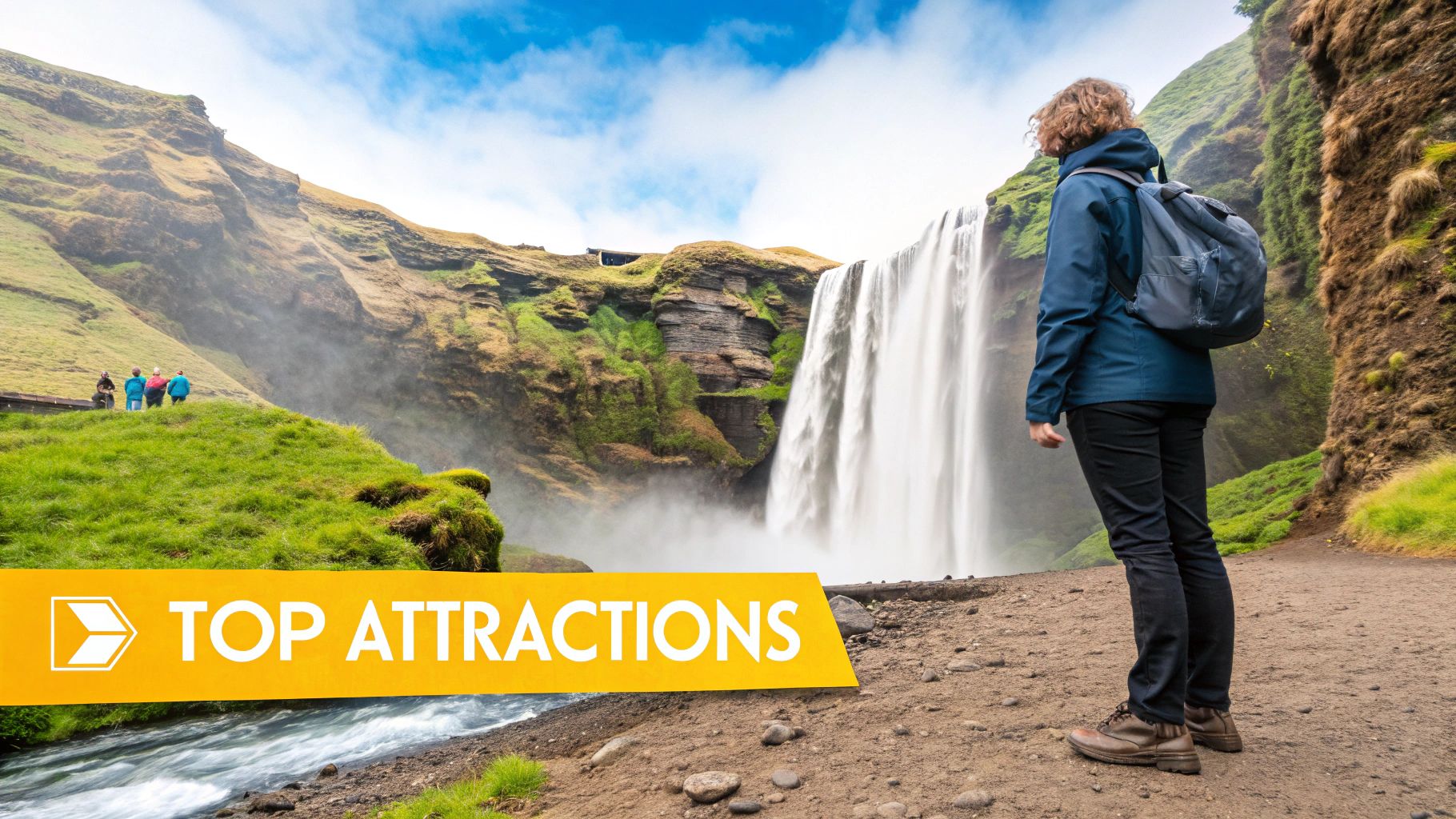
Driving from Glasgow to the Isle of Skye is an absolute dream, but it’s not your typical road trip. The Highlands have a personality of their own, from the winding roads to the notoriously unpredictable weather. A bit of practical knowledge goes a long way, transforming a good trip into an unforgettable one by helping you sidestep common headaches.
This isn’t just about getting from A to B. It’s about knowing how to handle the roads, what to expect, and how to stay comfortable. Here’s my firsthand advice to make your journey smoother, safer, and much more enjoyable.
Renting the Right Car for the Highlands
What kind of car do you really need? It’s a common question, and thankfully, the answer is simple. While you might picture a burly 4×4 bouncing along a mountain pass, a standard compact or mid-size car is almost always the better choice.
Many of the most scenic roads are incredibly narrow, especially the single-track lanes. A smaller car is far less stressful to maneuver in tight spots and designated passing places. Unless you have very specific plans to go off-roading on private estates (which is rare), you just don’t need a huge vehicle.
I’d also strongly suggest an automatic transmission. If you’re not used to driving on the left, taking gear changes out of the equation on steep, winding roads is a game-changer. And before you hit the road, make sure your car is ready for the journey; it’s always a good idea to consult a comprehensive car maintenance checklist.
Mastering the Art of the Single-Track Road
Many of the best roads in the Highlands and on Skye are single-track. They look intimidating, but they operate on a simple, unspoken etiquette.
- Understand Passing Places: These are the little pull-offs you’ll see frequently, marked by signs. They are not for parking or photo ops. Their only job is to let traffic flow in both directions.
- Know Who Pulls In: The unwritten rule is that the car closest to a passing place on their side of the road pulls in to wait. If the spot is on the opposite side, you should stop on the main road to allow the oncoming car to pull into it.
- Don’t Fear Reversing: You will inevitably meet another car between passing places. It happens. One of you will need to back up to the nearest spot. Just be courteous and patient.
- Give the “Thank You” Wave: This is essential! A quick wave to a driver who has pulled over for you is part of the experience. It keeps things friendly for everyone.
Navigating a single-track road isn’t a race. Common courtesy suggests that the car driving uphill has the right of way, since it’s much harder to get going again on an incline. The best advice? Slow down, look far ahead, and soak in the views.
Booking Well in Advance Is Non-Negotiable
If you take only one piece of advice, let it be this: book everything early. From May through September, the route is incredibly popular. While spontaneity sounds romantic, showing up without a reservation will likely lead to a night in your car.
I can’t stress this enough—book your accommodation and rental car at least 4-6 months in advance, especially for a summer trip. The best B&Bs and hotels are the first to go, and last-minute car rentals are notoriously expensive. For those who want a bit of structure without sacrificing freedom, looking into a pre-planned itinerary like an 8-day self-drive tour of Scotland can be a great option, as it often includes pre-booked stays.
Practical Packing and Navigating the Highlands
Scottish weather lives up to its reputation. You can easily see sunshine, rain, wind, and calm all in one afternoon. Packing accordingly is key.
| Essential Item | Why You Need It |
|---|---|
| Waterproof Jacket | Not just “water-resistant.” A proper, sealed-seam waterproof is a must. |
| Layers of Clothing | A mix of t-shirts, fleeces, and thermals lets you adjust on the fly. |
| Sturdy Footwear | You’ll want to explore, so bring waterproof walking shoes or boots. |
| Midge Repellent | From June to August, the Highland midge is no joke. Come prepared! |
| Offline Maps | Don’t count on having a signal. It’s patchy at best in remote areas. |
On that last point, your phone’s data connection will disappear when you need it most. Before you leave, download the entire region on Google Maps or another offline map app. It’s a lifesaver when you’re deep in a glen, searching for that hidden waterfall or your accommodation for the night.
Answering Your Glasgow to Isle of Skye Road Trip Questions
Alright, let’s wrap this up by tackling some of the most common questions I hear from people planning this incredible drive. Getting these sorted can genuinely be the difference between a good trip and a truly great one. Think of this as your final check-in before you hit the road, ensuring your adventure is as smooth as a fine single malt.
How Many Days Do You Really Need for This Trip?
This is the big one, and honestly, the answer shapes your entire plan. You could technically bomb it up the road in about 5-6 hours without stopping, but you’d be missing the entire point. That’s like going to a feast and only eating the bread.
Here’s my take on how to do it right:
- The Drive Up: Give the drive from Glasgow to the Skye Bridge its own day. I’m talking a full 8-10 hours. This gives you the freedom to pull over for that perfect photo, take a proper walk in Glencoe, and not feel like you’re racing the sunset.
- The Overnight Stop: To really savour the journey, break it up. An overnight stay in a place like Glencoe, Ballachulish, or Fort William is a fantastic idea. It splits the drive into two relaxed halves and lets you wake up already surrounded by Highland scenery.
- Time on Skye: Once you’re on the island, you need at least two full days just to scratch the surface. If you can stretch it to three, you’ll be glad you did. It gives you enough breathing room to properly explore different corners like the Trotternish Peninsula or Duirinish without constantly checking your watch.
So, what’s the verdict? For a trip that feels rewarding and not rushed, you’re looking at a minimum of 3-4 days: one for the journey up, and two or three to soak up the magic of Skye itself.
Is the Drive from Glasgow to Skye Difficult?
For anyone with a bit of driving confidence, the route isn’t overly difficult, but it’s certainly not your average motorway cruise. The main roads, like the A82, are well-kept and plenty wide for comfortable driving.
The real challenge, especially if you’re not from the UK, is the single-track roads. You’ll find these all over Skye and in some of the more remote mainland spots. They’re narrow lanes with designated “passing places” that allow you and oncoming traffic to get by each other.
The secret to single-track roads is a mix of patience and courtesy. It’s not a race. Look far ahead, be ready to pull into a passing place (or even reverse to one), and always give a friendly wave to the driver who stops for you. It’s an unspoken rule of the road up here.
What Is the Most Scenic Part of the Drive?
Beauty is in the eye of the beholder, of course, but almost everyone agrees on one stretch of road: the A82 as it drops into Glencoe. There’s nothing else quite like it. As you descend into the valley, these immense, moody mountains just swallow you up. The scale is staggering, and you can practically feel the history in the air.
That’s not to say the rest of the drive is boring! Other jaw-dropping moments include:
- Winding along the famous “bonnie banks” of Loch Lomond.
- Crossing the vast, empty, and strangely beautiful expanse of Rannoch Moor just before Glencoe.
- That first, iconic glimpse of Eilean Donan Castle as you get close to the Skye Bridge.
Every leg of the journey has its own distinct flavour of Scottish beauty, but for many, Glencoe is the absolute showstopper.
When Is the Best Time of Year to Go?
Picking your season is crucial. It dictates everything from crowds and weather to your potential encounters with the infamous Scottish midge.
Hands down, the best time for this road trip is in the shoulder seasons. I’m talking May, early June, and September. This is the sweet spot. You generally get:
- Pleasant weather and long daylight hours.
- Far fewer people than the peak summer crush in July and August.
- A lush, green landscape (or the first hint of autumn gold).
- Best of all, the midges are either not out yet or have mostly vanished.
April and October can also be stunning, with dramatic light and even smaller crowds, but the weather is a gamble—you’re more likely to get hit with chilly spells and rain. Winter (November-March) can be magical, with snow-capped peaks and no one around, but it’s for the more adventurous driver. You’ll be dealing with very short days, the real possibility of road closures, and fewer open hotels and restaurants.
Planning the perfect Scottish self-drive adventure is what BTOURS does best. We create curated itineraries that let you explore the Highlands’ most stunning landscapes at your own pace, with the freedom to discover hidden gems along the way. Start planning your unforgettable journey with us today!

